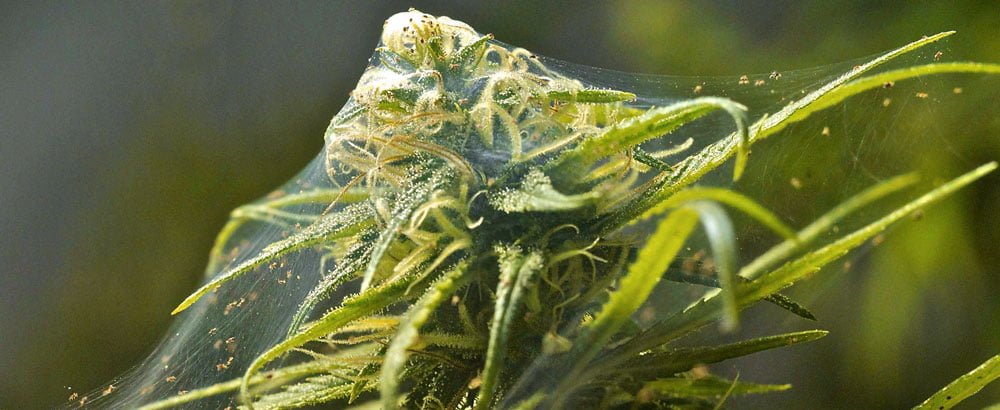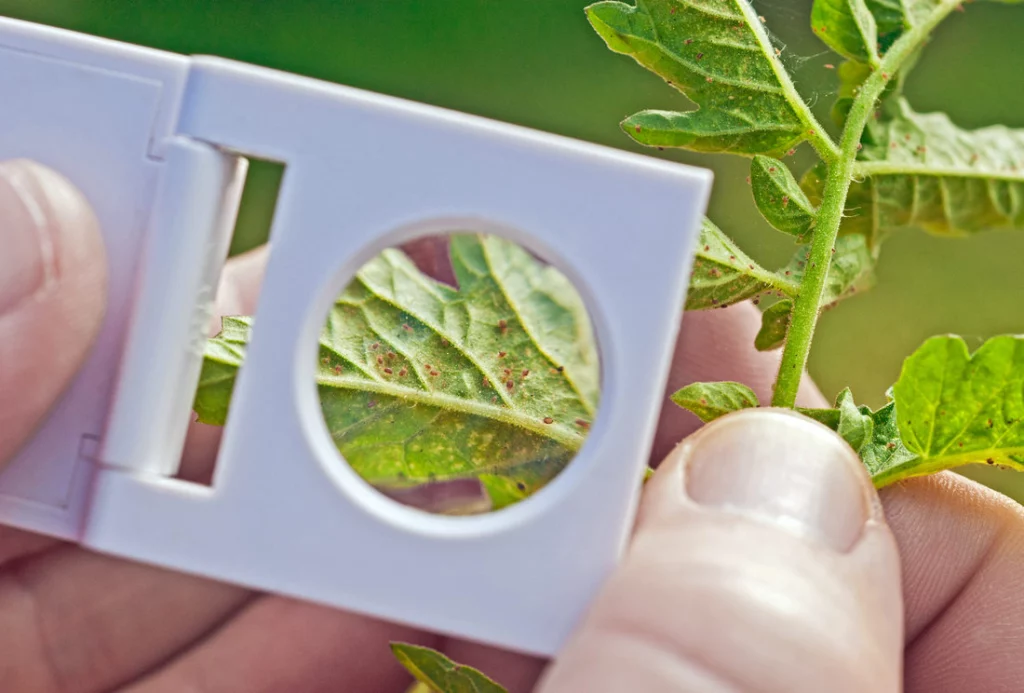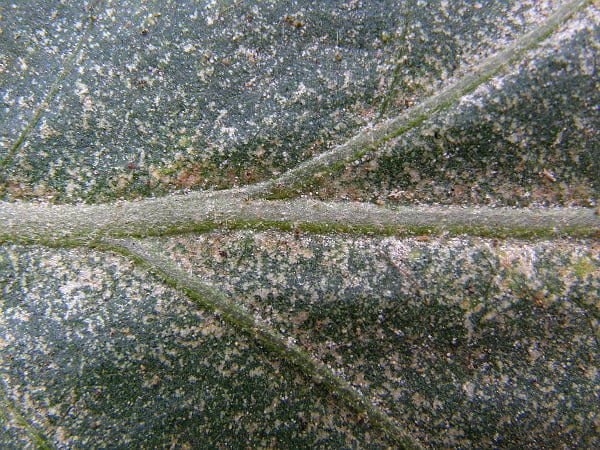English
Spider mites – Tetranychus
Spider mite infestations are initially subtle and may resemble a situation where cannabis plants are not getting the nutrients they need. However, you can tell that there really is a spider mite on the leaves by the fact that they gradually turn pale and yellow, as these pests gradually suck all the sap out of the leaves, weakening and killing the cannabis plants.
Initial visible symptoms include small whitish or yellowish spots on the leaves, especially around the midrib and near the larger veins. Later, these spots enlarge and begin to coalesce into larger maps, with the empty cells giving parts of the leaf a whitish or even silvery transparent hue. The leaves then turn yellow, brown, gradually dry, die and fall off.
It is easy to detect the presence of these little rascals if you examine the stems and undersides of the leaves carefully, especially with a magnifying glass. This is where you are more likely to see spider mites than on the flowers or fruit. If there is then a large overgrowth of spider mites, you may also notice fine (but sometimes very dense) webs where the leaf stalks are adjacent to the stems or twigs.
In some cases, there are even tiny moving dots in the web, which can be recognised by their distinctive colouring. However, not all pests produce these threads. For example, the fruit spidermite, which is probably the best known after the hop spidermite, does not spin any webs.
So what can we observe on infected cannabis plants?
Leaves – light or silvery colour, yellowish spots in the suckering area, chlorosis, dry necrotic areas, lifting of margins, drying.
If the cannabis infestation is invasive, the symptoms can resemble the sudden wilting and unwarranted withering of marijuana plants. In some years, when there is a wet warm spring and a dry summer with minimal rainfall, spider mites then multiply significantly and weaken the cannabis plants.
Spider mites ideally thrive in places that are overheated, where the air is kept dry and where their natural enemies cannot attack them. Intense infestation of plants by spider mites can subsequently cause them to die rapidly. In the flowering phase, the infestation is very intense and the spider-mites have extremely fast reproductive cycles, so their population exponentialy grows.
How to get rid of spider mites
Speed plays a really important role, as one female is able to lay up to a hundred eggs during her lifetime, which soon hatch into new individuals that can also lay eggs themselves.
If you notice the presence of pests early on, when the spider mite infestation is fresh, it may help to shower the plants and wash the leaves with a damp sponge. However, most cannabis growers don’t notice early on that something is wrong with their cannabis plants, and when they do, they often don’t attribute the problem to spider mites. Once the pest is discovered, it is then necessary to resort to other effective methods.
How to get rid of pests in the greenhouse, in the garden or indoors? You have few options. The first is the application of a natural predator, which you can find, for example, on the internet. Then there are systemic poisons, chemical sprays and organic poisons.
Predators
When plants are infested with spider mites, their natural enemies can be used to kill the pests. These predators called Phytoseiulus persimilis, represent a kind of biological weapon that effectively destroys mites. They are bright orange in colour, move very quickly and can suck up to five adult bugs or twenty larvae and eggs in a single day. They pose no threat to plants.
Unfortunately, as this predatory mite is very sensitive to microclimates, it is not guaranteed to thrive on your plants. It is particularly sensitive to temperature, low humidity and some chemicals used to protect cannabis plants. Therefore, beware of other methods used at the same time to kill the pests. Contact spraying can kill not only the pest but also the small helpers that effectively kill the mites.
Chemical spraying
Don’t know how to get rid of mites? Many recommend chemical products that are highly effective and can save even heavily infested marijuana plants. The problem, however, is that these sprays can also kill what you don’t want (such as the aforementioned predators). In addition, they have a protection period during which the ganja cannot be harvested.
Keep in mind, however, that the population of pests in a greenhouse or cannabis cultivation facility can become resistant to some chemicals over a short period of time, so it is better to combine chemical sprays.
Gentle product against spider mites
Of course, there are all sorts of chemical products on the market today that promise to eliminate pests quickly, but you can also try an organic spray against spider mites. These products are based on natural substances such as various salts or oils.
The great advantage of these organic preparations against spidermites is the fact that, unlike chemical preparations, they tend to be gentler and better suited to enclosed spaces. So you can use them indoors without fear of toxic effects that some substances might have on you or your pets.
However, with a heavy infestation, it is very difficult to eradicate mites completely using organic products.
Homemade spray
Do you want to use a homemade spray for spider mites? We have a tip for you for chamomile or onion decoction.
You can make a chamomile decoction from six tablespoons of chamomile flowers poured over a litre of boiling water. You then leave everything to infuse, and once it is done, strain the decoction through a sieve or stocking. The finished solution can then be diluted 1:5 and the plants can be treated, which should be repeated approximately every 3 to 4 days for three weeks.
Onion decoction is made from the skins of several onions. As in the case of chamomile, pour boiling water over them, leave to infuse for 3 days and then strain the liquor through a sieve or stocking. Pour the finished solution, which does not need to be diluted, into a spray bottle, spray the plants thoroughly and repeat the procedure several times over the following weeks.
Prevention
Spider mites like drought and high temperatures, which have a major effect on the growth rate of the spider mites population. Therefore, one prevention in the garden or greenhouse is frequent but adequate watering and watering of the soil around the cannabis plants. Indoors, keeping relative humidity and temperature at borderline levels is an effective prevention. Optimum humidity is up to 80-90 % and temperature around 20-25 °C depending on the variety. We recommend very frequent checks on plants, especially in the 1-2 weeks before the end of the growth phase, because in the flowering phase it is often already futile to combat the expanding colonies of the spidermites, not least because it is no longer possible to slow down the expansion of the pests with moisture. It is no longer possible to use sprays on the formed buds, and systemic poisons usually have a protection period of about a month, so it is basically impossible to get rid of the spider mites completely in late flowering. We can only reduce parasitic colonies by mechanical removal, removing nets and adding natural predators.
Published by Peca Sarm
02/12/2021choose and buy cannabis seeds from our offer
our pleasure



























